This article was published in Scientific American’s former blog network and reflects the views of the author, not necessarily those of Scientific American
Raptors – birds of prey – are among the most remarkable, charismatic and startling of birds. We’re talking about a group of hook-billed predators where there are species that predate on everything from insects and fish to large terrestrial mammals and fast-flying birds, that have taken to life in high mountains, dense tropical forests, the fringes of the oceans and everywhere in between, and are sometimes equipped with remarkable power, most notably in the bill and their massively taloned feet.
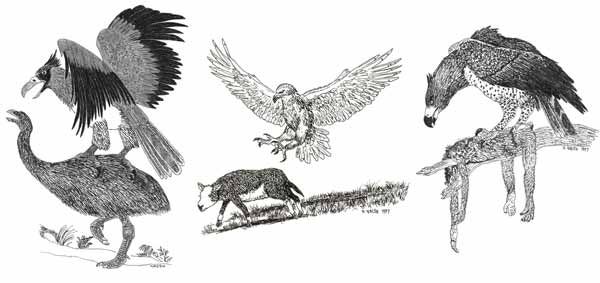
Images you might recognise as a long-time denizen of the TetZooniverse, all based on reality. Eagles vs giant ratites, eagles vs domestic cattle, eagles vs hominins... Credit: Darren Naish
Here, I’m referring specifically to accipitriforms: the New World vultures, secretarybirds, ospreys, Old World vultures, kites, harriers, hawks and eagles. Falcons are not part of this group – instead being close kin of parrots and passerines – hence abandonment of the term Falconiformes for the entire lot.
On supporting science journalism
If you're enjoying this article, consider supporting our award-winning journalism by subscribing. By purchasing a subscription you are helping to ensure the future of impactful stories about the discoveries and ideas shaping our world today.
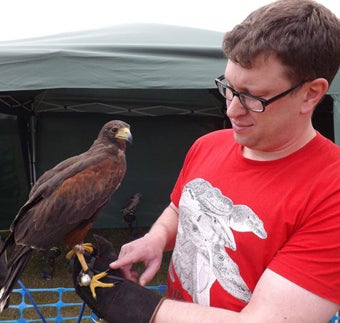
Your humble author with a trained Harris hawk Parabuteo unicinctus... or Harris’s hawk. Credit: Darren Naish
And, yes, I aim to use the word raptors as much as possible in this article because I want to remind you that the word raptor is already in use for the group of birds called raptors. I find it irksome and really inconvenient that some people now associate the term with dromaeosaurids. Anyway... here’s a quick run-down of raptor diversity, history and phylogeny. I have them on my mind as I’ve been working on the extensive raptor section of the giant textbook I’m compiling (on which go here). Several especially good books tackle raptors, some of my favourites including the 1990 Merehurst Birds of Prey (Newton 1990), and Leslie Brown’s Birds of Prey (Brown 1976a) and Eagles of the World (Brown 1976b). Needless to say, Volume 2 of the Handbook of the Birds of the World is also really useful for specialists.

Compelling proof that New World vultures really are close kin of other accipitriforms: they adopt identical pooping postures. At left, juvenile Andean condor Vultur gryphus. At right, White-tailed sea eagle Haliaeetus albicilla. Credit: Darren Naish
Condors and other New World vultures. We start with New World vultures, a group unique to the Americas today, but with a fossil record that involves Europe. This group is most frequently termed Cathartidae but the name Vulturidae is also used here and there, and right now it isn’t totally clear (at least, not to me) which is ‘correct’; both are in current use. There are only seven living species: the two condors, a few mid-sized species, and the King vulture Sarcoramphus papa, a species that shares features with condors and seems closer to them than it is to the smaller species. It may actually be a condor if some recent molecular results prove correct (Johnson et al. 2016).
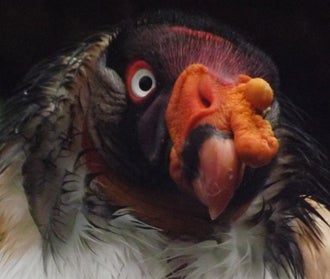
The King vulture Sarcoramphus papa - it might, arguably, be better termed the King condor - is a remarkably flamboyant, boldly patterned New World vulture. Credit: Darren Naish
As I’ve said at Tet Zoo on many previous occasions, the idea that New World vultures are close kin of storks is – even today – often mentioned as if it’s a cutting-edge and avant-garde idea which demonstrates the up-to-dateness of the person mentioning it. It’s true that several studies of the 1960s and early 90s did support such an affinity (a result being that various books and articles of the late 20th century classify New World vultures as part of Ciconiiformes*), but it’s absolutely not supported today. New World vultures really are close relatives of hawks, eagles and kin while storks are part of the waterbird assemblage and in a completely different part of the tree (e.g., Hackett et al. 2008, Prum et al. 2015).
* Though this issue is made more complex by the fact that Sibley & Ahlquist (1990) recognised a gigantic, super-inclusive version of Ciconiiformes that included numerous neoavian groups never previously included within that group.
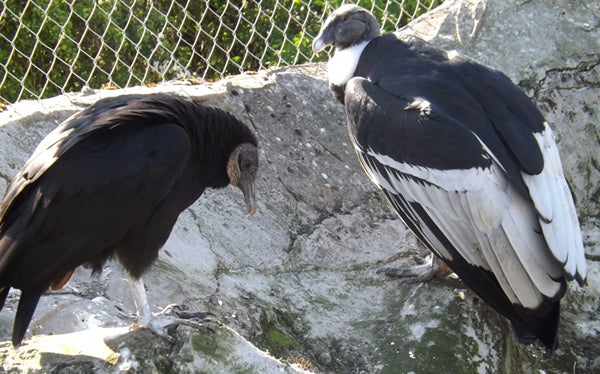
It isn’t difficult to see New World vultures of two or more species together, since they’re often attracted to the same carcasses. But these birds are in captivity (Chester Zoo, UK). At left: a Black vulture Coragyps atratus. At right: Andean condor. Credit: Darren Naish
New World vultures are famed for their excellent sense of smell, their specialisation for carrion-feeding, the flamboyant display features of species like the King vulture and Andean condor Vultur gryphus, and for the giant size of the condors (a very large Andean condor can reach 3.2 m in wingspan and weigh 15 kg). They have a rich fossil record that reveals an interesting former diversity and more complex guild structure than that present today.
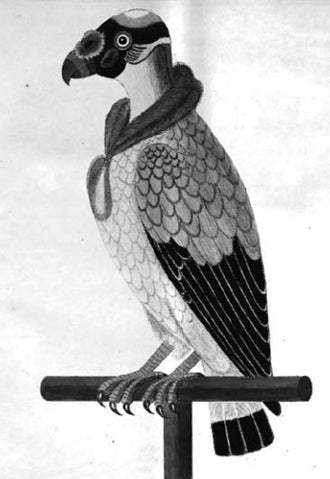
Albin’s 1734 illustration of the ‘Warwovwen or Indian vulture’, almost certainly the same as thing as Bartram’s Painted vulture. Credit: Snyder & Fry 2013b
The Painted vulture. A curiosity concerns the alleged existence of a white-tailed relative of the King vulture: the Painted vulture S. sacra, supposedly observed by William Bartram in Florida in 1791. Views on this bird have wavered from full-fledged acceptance of the existence of a distinctive Sarcoramphus vulture in the southern USA to the more popular idea that it was mythical, based on an inaccurate or confused reporting of anatomical features, or a garbled composite of raptors of more than one species (Harper 1936). Most recently, Snyder & Fry (2013a, b) argued that the bird – described and illustrated independently by Eleazar Albin in 1734 following observation of a ‘Warwovwen or Indian vulture’ imported to England from the New World – likely was a valid entity… not the result I was expecting!

Skeleton of Teratornis merriami at the Page Museum, Los Angeles. This skeleton is behind glass and is notoriously difficult to photograph. Credit: Eden, Janine and Jim Flickr (CC BY 2.0)
What about teratorns? On the subject of extinct raptors… what about teratorns (properly teratornithids), that famous group so frequently depicted as ‘mega-vultures’ or ‘mega-condors’? There’s a lot that could be said about this amazing group and here I simply don’t want to share everything I’m putting into the textbook. But… the biggest teratorn (Argentavis from the Upper Miocene of Argentina) had a wingspan of 6-8 m and weighed somewhere between 65 and 120 kg. Yes, it could almost certainly fly, and it was likely dependent on local atmospheric conditions and was unable to take to the air in inclement or non-ideal conditions.
Features of the pelvis, hindlimbs and skull indicate that teratorns were adept on the ground, were capable predators of reasonably large animals (though they surely did not kill things in eagle-like fashion), but that they were also thermal soarers that scavenged on large animals and probably used their size and strength to take over the kills of predatory mammals.
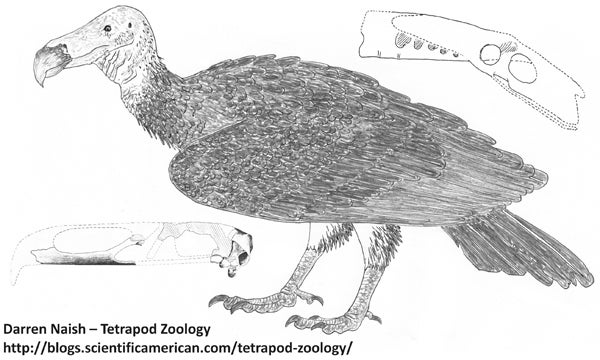
Reconstruction of Teratornis, produced for The Big Book where it features in various montages and cladograms and such. Features of the pelvis (that of Teratornis is shown at top right, from Campbell & Tonni (1983)) and the long, robust skull (that of Argentavis is shown at bottom left, from Campbell & Tonni (1980)) indicate that teratorns were good walkers and capable of tackling reasonably large prey, in addition to carrion. Credit: Darren Naish
Teratorns are mostly associated with the fossil record of the Pleistocene but Taubatornis from Brazil takes their record back to the Upper Oligocene or Lower Miocene. There’s been very little study of their phylogeny but it does look likely, based on tarsometatarsal anatomy and other part of the skeleton, that they’re close kin of New World vultures. That will have to do: as I said above, there’s tons more than could be said on these birds and the section on them in my textbook is pretty long.
And, indeed, there’s tons more to say on raptors in general. Next: more raptors! For previous Tet Zoo articles on raptors, see...
Refs - -
Brown, L. 1976a. Birds of Prey. Reed International Books, London.
Brown, L. 1976b. Eagles of the World. David & Charles, Newton Abbot.
Campbell, K. E. & Tonni, E. P. 1980. A new genus of teratorn from the Huayquerian of Argentina (Aves: Teratornithidae). Natural History Museum of Los Angeles County, Contributions in Science 330, 59-68.
Campbell, K. E. & Tonni, E. P. 1983. Size and locomotion in teratorns (Aves: Teratornithidae). The Auk 100, 390-403.
Hackett, S. J., Kimball, R. T., Reddy, S., Bowie, R. C. K., Braun, E. L., Braun, M. J., Cjojnowski, J. L., Cox, W. A., Han, K.-L., Harshman, J., Huddleston, C. J., Marks, B., Miglia, K. J., Moore, W. S., Sheldon, F. H., Steadman, D. W., Witt, C. C. & Yuri, T. 2008. A phylogenomic study of birds reveals their evolutionary history. Science 320, 1763-1768.
Harper, F. 1936. The Vultur sacra of William Bartram. Auk 53, 381-392.
Johnson, J. A., Brown, J. W., Fuchs, J. & Mindell, D. P. 2016. Multi-locus phylogenetic inference among New World Vultures (Aves: Cathartidae). Molecular Phylogenetics and Evolution 105, 193-199.
Newton, I. 1990. Birds of Prey. Merehurst, London.
Prum, R. O., Berv, J. S., Dornburg, A., Field, D. J., Townsend, J. P., Moriarty Lemmon, E. & Lemmon, A. R. 2015. A comprehensive phylogeny of birds (Aves) using targeted next-generation DNA sequencing. Nature 526, 569-573.
Sibley, C. G. & Ahlquist, J. A. 1990. Phylogeny and Classification of Birds. New Haven: Yale University Press.
Synder, N. F. R. & Fry, J. T. 2013a. Validity of Bartram’s painted vulture (Aves: Cathartidae). Zootaxa 3613, 61-82.